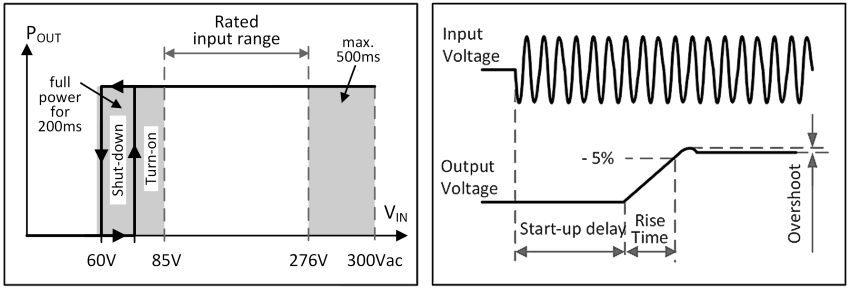AC input
AC input | |||
|---|---|---|---|
AC input | Nom. | AC 100 - 240 V | Suitable for TN, TT and IT networks |
AC input range | Min. | 85 - 276 Vac | Continuous operation |
Min. | 60 - 85 Vac | Full power for 200 ms, no damage between 0 and 85 Vac | |
Min. | 276 - 300 Vac | For up to 500 ms max. | |
Permissible voltage L or N to earth | Max. | 276 Vac | Continuous according to IEC 62103 |
Input frequency | Nom. | 50 - 60 Hz | ±6% |
Turn-on voltage | typically | 77 Vac | Static, see Fig. Input voltage range; Turn-on behavior definitions |
Shut-down voltage | typically | 73 Vac | Static, see Fig. Input voltage range; Turn-on behavior definitions |
typically | 53 Vac | Dynamic value | |
AC input |
| AC 100 V | AC 120 V | AC 230 V |
|
|---|---|---|---|---|---|
Input current | typically | 5.47 A | 4.56 A | 2.48 A | At 24 V, 20 A, see Fig. Input current over output current; power factor over output current |
Power factor*) | typically | 0.96 | 0.95 | 0.90 | At 24 V, 20 A, see Fig. Input current over output current; power factor over output current |
Peak factor**) | typically | 1.6 | 1.7 | 2,05 | At 24 V, 20 A |
Start-up delay | typically | 640 ms | 610 ms | 660 ms | See Fig. Input voltage range; Turn-on behavior definitions |
Rise time | typically | 80 ms | 80 ms | 80 ms | At 24 V, 20 A, 0 mF load capacity, see Fig. Input voltage range; Turn-on behavior definitions |
typically | 85 ms | 85 ms | 85 ms | at 24 V, 20 A, 20 mF load capacity, see Fig. Input voltage range; Turn-on behavior definitions | |
Turn-on overshoot | Max. | 100 mV | 100 mV | 100 mV | See Fig. Input voltage range; Turn-on behavior definitions |
*) The power factor is the ratio of real (or active) power to apparent power in an AC circuit.
**) The peak factor is the mathematical ratio of the peak value to the RMS value of the input current waveform.

